Mapping Soil Organic Carbon Content in Patagonian Forests Based on Climate, Topography and Vegetation Metrics from Satellite Imagery
Abstract
1. Introduction
2. Materials and Methods
2.1. Study Area and Sampling Design
2.2. Soil Sampling and Calculation of Soil Organic Carbon
2.3. Remotely Sensed Predictor Variables and Auxiliary Information
2.4. Modeling and Mapping the Soil Organic Carbon
2.5. Data Extraction and Output Analyses
3. Results
3.1. Performance of the Soil Organic Carbon Model
3.2. Soil Organic Carbon Stocks in Patagonian Forests
4. Discussion
4.1. Advantages and Limitations of the Modeling
4.2. Soil Organic Carbon Stocks in Patagonian Forests
4.3. Recommendations for Monitoring and Policy Makers
5. Conclusions
Author Contributions
Funding
Institutional Review Board Statement
Informed Consent Statement
Data Availability Statement
Acknowledgments
Conflicts of Interest
Appendix A
| Type | FC (km2) | SOC (ton C ha−1) | SD (ton C ha−1) | Total SOC (million ton C) | |
|---|---|---|---|---|---|
| TDF | NP | 4054.0 | 158.5 | 22.7 | 64.2 |
| NA | 2007.3 | 141.1 | 22.3 | 28.3 | |
| N-MIX | 0.0 | -- | -- | 0.0 | |
| N-EVE | 1013.7 | 186.3 | 29.9 | 18.9 | |
| CON | 0.0 | -- | -- | 0.0 | |
| EVE | 0.0 | -- | -- | 0.0 | |
| MIX | 217.4 | 175.4 | 31.7 | 3.8 | |
| SC | NP | 2104.4 | 125.2 | 15.7 | 26.3 |
| NA | 260.2 | 122.8 | 16.4 | 3.2 | |
| N-MIX | 30.2 | 123.7 | 15.3 | 0.4 | |
| N-EVE | 0.0 | -- | -- | 0.0 | |
| CON | 0.1 | 139.8 | 20.2 | 0.0 | |
| EVE | 0.0 | -- | -- | 0.0 | |
| MIX | 75.0 | 142.0 | 17.5 | 1.1 | |
| CHU | NP | 4232.4 | 124.5 | 13.7 | 52.7 |
| NA | 2239.1 | 130.2 | 21.6 | 29.1 | |
| N-MIX | 14.4 | 118.7 | 18.7 | 0.2 | |
| N-EVE | 1013.4 | 134.6 | 16.8 | 13.6 | |
| CON | 521.7 | 125.2 | 17.8 | 6.5 | |
| EVE | 26.3 | 127.2 | 18.5 | 0.3 | |
| MIX | 344.0 | 134.0 | 16.1 | 4.6 | |
| RN | NP | 1835.2 | 128.6 | 15.4 | 23.6 |
| NA | 747.7 | 129.4 | 19.6 | 9.7 | |
| N-MIX | 7.2 | 127.5 | 20.7 | 0.1 | |
| N-EVE | 546.4 | 128.8 | 13.6 | 7.0 | |
| CON | 318.4 | 126.7 | 17.4 | 4.0 | |
| EVE | 9.6 | 124.0 | 18.2 | 0.1 | |
| MIX | 275.9 | 127.4 | 13.9 | 3.5 | |
| NQN | NP | 4001.2 | 129.6 | 19.7 | 51.9 |
| NA | 1023.8 | 121.2 | 22.7 | 12.4 | |
| N-MIX | 253.6 | 129.9 | 18.2 | 3.3 | |
| N-EVE | 1198.2 | 126.9 | 13.3 | 15.2 | |
| CON | 956.2 | 108.7 | 23.5 | 10.4 | |
| EVE | 15.3 | 118.7 | 14.5 | 0.2 | |
| MIX | 729.1 | 128.7 | 17.7 | 9.4 | |
| Type | FC (km2) | SOC (ton C ha−1) | SD (ton C ha−1) | Total SOC (million ton C) | |
|---|---|---|---|---|---|
| Red | NP | 6070.4 | 135.3 | 22.0 | 82.1 |
| NA | 665.0 | 129.0 | 20.6 | 8.6 | |
| N-MIX | 28.2 | 124.5 | 23.3 | 0.4 | |
| N-EVE | 1259.5 | 163.6 | 37.0 | 20.6 | |
| CON | 260.0 | 120.8 | 21.1 | 3.1 | |
| EVE | 1.2 | 123.1 | 16.2 | 0.0 | |
| MIX | 507.0 | 145.5 | 28.8 | 7.4 | |
| Yellow | NP | 4843.5 | 138.9 | 26.4 | 67.3 |
| NA | 3687.0 | 134.8 | 23.2 | 49.7 | |
| N-MIX | 47.0 | 124.1 | 18.7 | 0.6 | |
| N-EVE | 593.2 | 146.3 | 33.6 | 8.7 | |
| CON | 717.8 | 117.5 | 22.5 | 8.4 | |
| EVE | 8.0 | 122.1 | 15.6 | 0.1 | |
| MIX | 304.1 | 136.6 | 27.4 | 4.2 | |
| Green | NP | 99.2 | 134.6 | 21.5 | 1.3 |
| NA | 219.1 | 132.6 | 18.3 | 2.9 | |
| N-MIX | 0.6 | 134.3 | 16.8 | 0.0 | |
| N-EVE | 36.4 | 126.4 | 15.5 | 0.5 | |
| CON | 102.3 | 128.7 | 17.8 | 1.3 | |
| EVE | 8.9 | 128.0 | 17.1 | 0.1 | |
| MIX | 23.3 | 130.2 | 20.5 | 0.3 | |
| Unclassified | NP | 5214.2 | 130.4 | 20.1 | 68.0 |
| NA | 1707.0 | 125.8 | 22.7 | 21.5 | |
| N-MIX | 229.6 | 130.1 | 17.6 | 3.0 | |
| N-EVE | 1882.7 | 133.5 | 20.2 | 25.1 | |
| CON | 716.4 | 112.0 | 23.4 | 8.0 | |
| EVE | 33.1 | 123.4 | 18.6 | 0.4 | |
| MIX | 806.9 | 131.3 | 19.2 | 10.6 | |
| Type | FC (km2) | SOC (ton C ha−1) | SD (ton C ha−1) | Total SOC (million ton C) | |
|---|---|---|---|---|---|
| NAT | NP | 5466.7 | 132.2 | 15.6 | 72.3 |
| NA | 991.1 | 132.5 | 17.7 | 13.1 | |
| N-MIX | 192.8 | 133.6 | 13.7 | 2.6 | |
| N-EVE | 2020.7 | 131.1 | 15.4 | 26.5 | |
| CON | 421.0 | 118.4 | 20.4 | 5.0 | |
| EVE | 22.3 | 125.6 | 18.2 | 0.3 | |
| MIX | 871.9 | 132.5 | 16.1 | 11.5 | |
| PRO | NP | 381.3 | 133.7 | 17.3 | 5.1 |
| NA | 118.2 | 129.0 | 18.5 | 1.5 | |
| N-MIX | 27.3 | 121.3 | 27.9 | 0.3 | |
| N-EVE | 172.8 | 129.0 | 14.4 | 2.2 | |
| CON | 123.3 | 117.9 | 24.1 | 1.5 | |
| EVE | 0.2 | 125.1 | 9.5 | 0.0 | |
| MIX | 66.1 | 129.5 | 16.1 | 0.9 | |
| UNP | NP | 10,379.3 | 136.2 | 26.2 | 141.4 |
| NA | 5168.8 | 131.6 | 24.0 | 68.0 | |
| N-MIX | 85.4 | 120.0 | 20.2 | 1.0 | |
| N-EVE | 1578.3 | 165.8 | 37.6 | 26.2 | |
| CON | 1252.2 | 115.6 | 23.5 | 14.5 | |
| EVE | 28.7 | 122.7 | 17.7 | 0.4 | |
| MIX | 703.5 | 142.5 | 32.3 | 10.0 | |
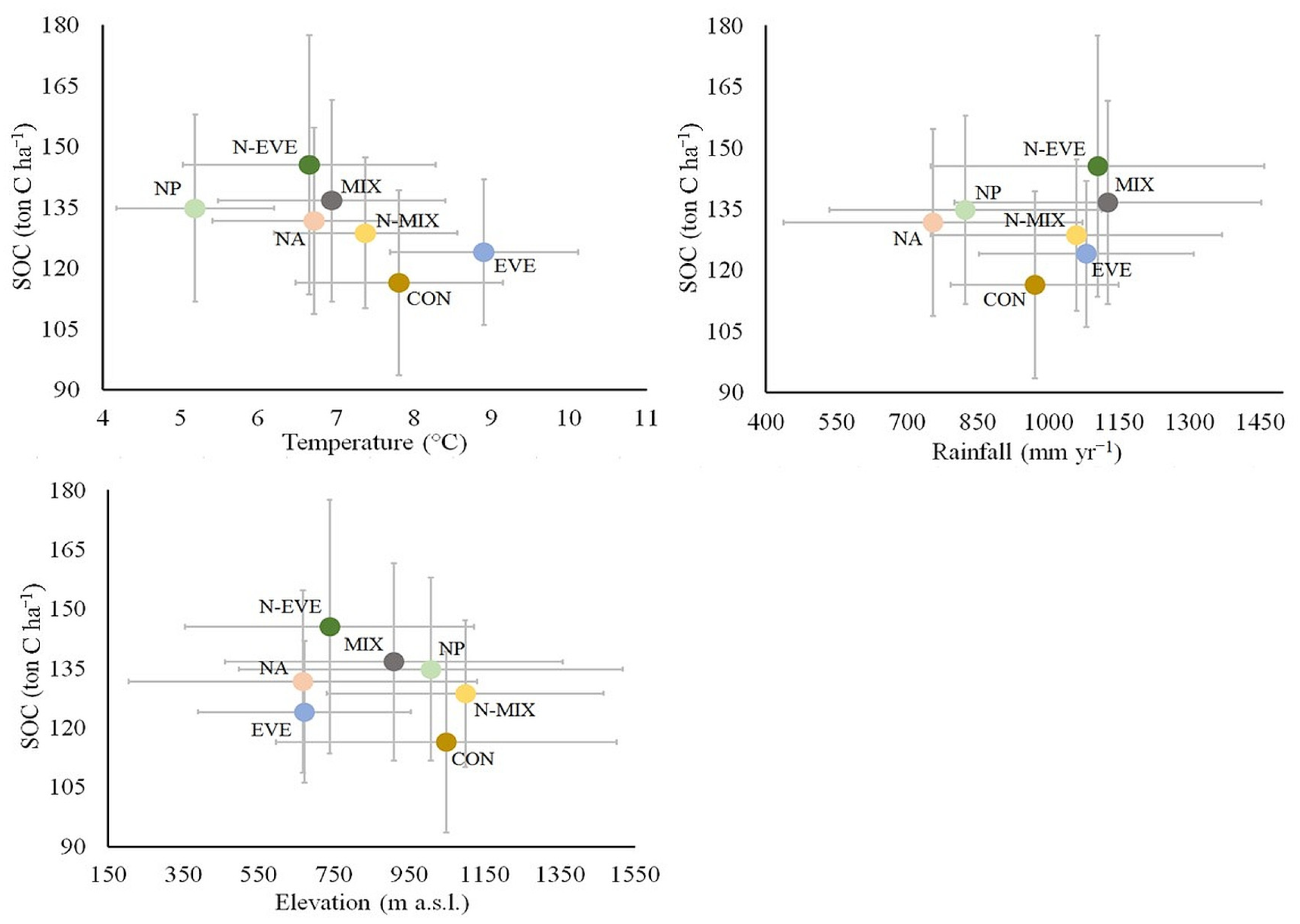


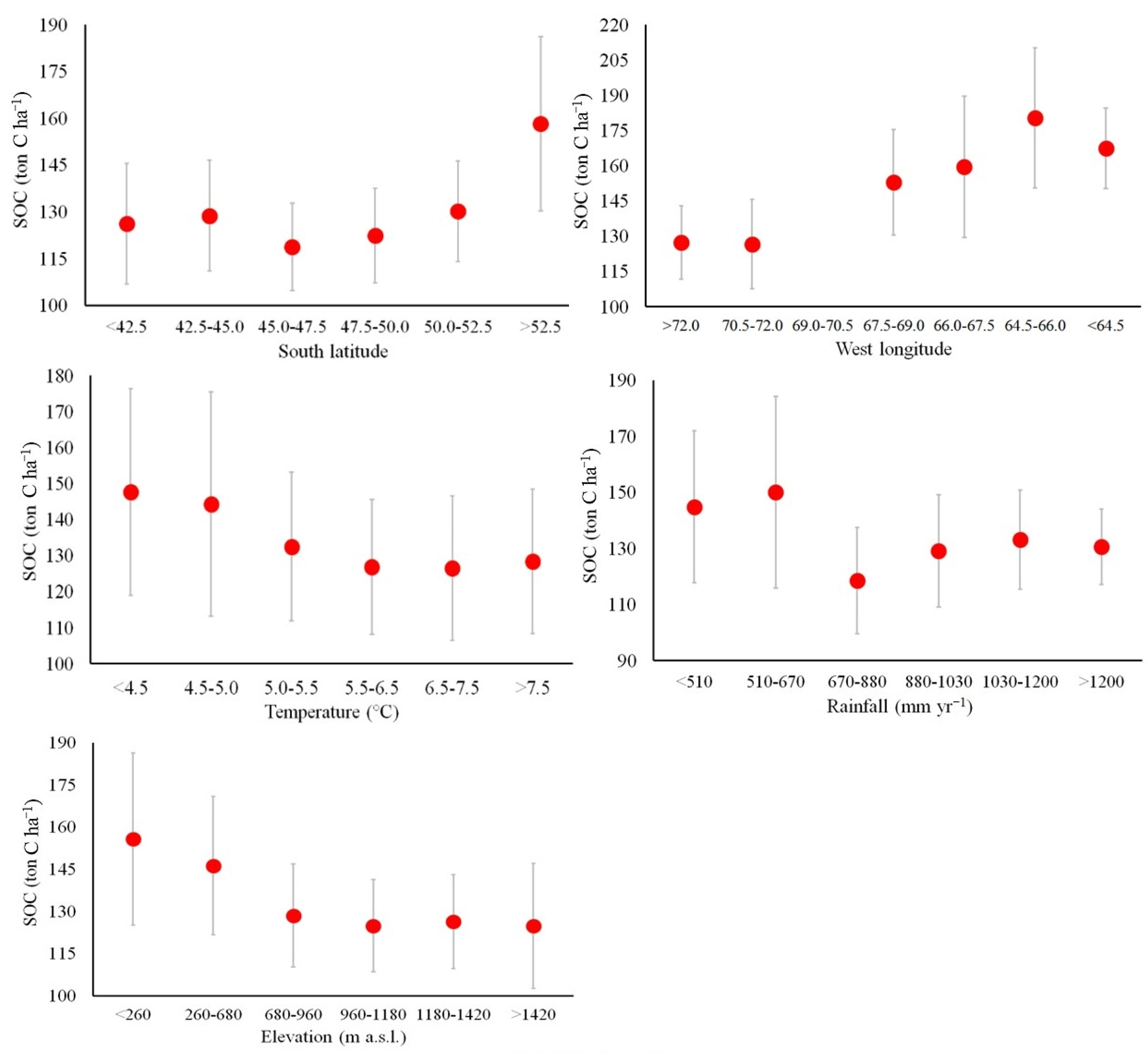
References
- Martínez Pastur, G.; Schlichter, T.; Matteucci, S.D.; Gowda, J.; Huertas Herrera, A.; Toro Manríquez, M.; Lencinas, M.V.; Cellini, J.M.; Peri, P.L. Synergies and trade-offs of national conservation policy and agro-forestry management over forest loss in Argentina during the last decade. In Latin America in Times of Global Environmental Change; Lorenzo, C., Ed.; The Latin American Studies Book Series; Springer: Cham, Switzerland, 2020; pp. 135–155. [Google Scholar]
- Ministerio de Ambiente y Desarrollo Sostenible de la Nación. Segundo Inventario Nacional de Bosques Nativos; Ministerio de Ambiente y Desarrollo Sostenible de la Nación: Buenos Aires, Argentina, 2020; 724p.
- Angelsen, A.; Martius, C.; De Sy, V.; Duchelle, A.E.; Larson, A.M.; Pham, T.T. Transforming REDD+: Lessons and New Directions; CIFOR: Bogor, Indonesia, 2018; 303p. [Google Scholar]
- Luque, S.; Martínez Pastur, G.; Echeverría, C.; Pacha, M.J. Overview of biodiversity loss in South America: A landscape perspective for sustainable forest management and conservation in temperate forests. In Landscape Ecology and Forest Management: Challenges and Solutions in a Changing Globe; Li, C., Lafortezza, R., Chen, J., Eds.; HEP-Springer: Amsterdam, The Netherlands, 2010; pp. 352–379. [Google Scholar]
- Angelstam, P.; Albulescu, C.; Andrianambinina, O.; Aszalós, R.; Borovichev, E.; Cano Cardona, W.; Dobrynin, D.; Fedoriak, M.; Firm, D.; Hunter, M.; et al. Frontiers of protected areas versus forest exploitation: Assessing habitat network functionality in 16 case study regions globally. AMBIO 2021, 50, 2286–2310. [Google Scholar] [CrossRef] [PubMed]
- Ministerio de Ambiente y Desarrollo Sustentable (MAyDS). Informe de Estado de Implementación 2010–2016 de la Ley N°26.331 de Presupuestos Mínimos de Protección Ambiental de los Bosques Nativos; Ministerio de Ambiente y Desarrollo Sostenible de la Nación: Buenos Aires, Argentina, 2017; 80p.
- Moreno, A.; Neumann, M.; Hasenauer, H. Optimal resolution for linking remotely sensed and forest inventory data in Europe. Rem. Sen. Environ. 2016, 183, 109–119. [Google Scholar] [CrossRef]
- Zald, H.; Wulder, M.A.; White, J.C.; Hilker, T.; Hermosilla, T.; Hobart, G.W.; Coops, N.C. Integrating Landsat pixel composites and change metrics with lidar plots to predictively map forest structure and aboveground biomass in Saskatchewan, Canada. Rem. Sen. Environ. 2016, 176, 188–201. [Google Scholar] [CrossRef]
- Silveira, E.M.O.; Terra, M.; ter Steege, H.; Maeda, E.; Acerbi Júnior, F.; Scolforo, J. Carbon-diversity hotspots and their owners in Brazilian southeastern savanna, Atlantic forest and semi-arid woodland domains. For. Ecol. Manag. 2019, 452, e117575. [Google Scholar] [CrossRef]
- Silveira, E.M.O.; Espírito Santo, F.; Wulder, M.A.; Acerbi Júnior, F.; Carvalho, M.C.; Mello, C.R.; Mello, J.M.; Shimabukuro, Y.E.; Terra, M.; Carvalho, L.; et al. Pre-stratified modelling plus residuals kriging reduces the uncertainty of aboveground biomass estimation and spatial distribution in heterogeneous savannas and forest environments. For. Ecol. Manag. 2019, 445, 96–109. [Google Scholar] [CrossRef]
- Coops, N.C.; Tompalski, P.; Goodbody, T.; Queinnec, M.; Luther, J.E.; Bolton, D.K.; White, J.C.; Wulder, M.A.; van Lier, O.R.; Hermosilla, T. Modelling LIDAR-derived estimates of forest attributes over space and time: A review of approaches and future trends. Rem. Sen. Environ. 2021, 260, e112477. [Google Scholar] [CrossRef]
- White, J.C.; Wulder, M.A.; Hobart, G.W.; Luther, J.E.; Hermosilla, T.; Griffiths, P.; Coops, N.C.; Hall, R.J.; Hostert, P.; Dyk, A.; et al. Pixel-based image compositing for large area dense time series applications and science. Can. J. Rem. Sen. 2014, 40, 192–212. [Google Scholar] [CrossRef]
- Li, Y.; Ramzan, M.; Li, X.; Murshed, M.; Awosusi, A.; Ibrahim, B.A.H.S.; Adebayo, T. Determinants of carbon emissions in Argentina: The roles of renewable energy consumption and globalization. Energy Rep. 2021, 7, 4747–4760. [Google Scholar] [CrossRef]
- Murshed, M.; Rashid, S.; Ulucak, R.; Dagar, V.; Rehman, A.; Alvarado, R.; Nathaniel, S.P. Mitigating energy production-based carbon dioxide emissions in Argentina: The roles of renewable energy and economic globalization. Environ. Sci. Poll. Res. 2022, 29, 16939–16958. [Google Scholar] [CrossRef]
- Peri, P.L.; Banegas, N.; Gasparri, I.; Carranza, C.; Rossner, B.; Martínez Pastur, G.; Caballero, L.; López, D.; Loto, D.; Fernández, P.; et al. Carbon sequestration in temperate silvopastoral systems, Argentina. In Integrating Landscapes: Agroforestry for Biodiversity Conservation and Food Sovereignty; Montagnini, F., Ed.; Springer Series: Advances in Agroforestry; Springer: Bern, Switzerland, 2017; pp. 453–478. [Google Scholar]
- Peri, P.L.; Lasagno, R.G.; Martínez Pastur, G.; Atkinson, R.; Thomas, E.; Ladd, B. Soil carbon is a useful surrogate for conservation planning in developing nations. Sci. Rep. 2019, 9, e3905. [Google Scholar] [CrossRef]
- Baldassini, P.; Bagnato, C.; Paruelo, J.M. How may deforestation rates and political instruments affect land use patterns and carbon emissions in the semi-arid Chaco, Argentina? Land Use Pol. 2020, 99, e104985. [Google Scholar] [CrossRef]
- Peri, P.L.; Gargaglione, V.; Martínez Pastur, G.; Lencinas, M.V. Carbon accumulation along a stand development sequence of Nothofagus antarctica forests across a gradient in site quality in Southern Patagonia. For. Ecol. Manag. 2010, 260, 229–237. [Google Scholar] [CrossRef]
- Peri, P.L.; Rosas, Y.M.; Ladd, B.; Toledo, S.; Lasagno, R.G.; Martínez Pastur, G. Modelling soil carbon content in South Patagonia and evaluating changes according to climate, vegetation, desertification and grazing. Sustainability 2018, 10, 438. [Google Scholar] [CrossRef]
- Peri, P.L.; Rosas, Y.M.; Ladd, B.; Díaz Delgado, R.; Martínez Pastur, G. Carbon footprint of lamb and wool production at farm and regional scales in Southern Patagonia. Sustainability 2020, 12, 3077. [Google Scholar] [CrossRef]
- de Koning, F.; Olschewski, R.; Veldkamp, E.; Benítez, P.; López-Ulloa, M.; Schlichter, T.; de Urquiza, M. The ecological and economic potential of carbon sequestration in forests: Examples from South America. AMBIO 2005, 34, 224–229. [Google Scholar] [CrossRef] [PubMed]
- Defossé, G.E.; Loguercio, G.; Oddi, F.J.; Kraus, P.D. Potential CO2 emissions mitigation through forest prescribed burning: A case study in Patagonia, Argentina. For. Ecol. Manag. 2011, 261, 2243–2254. [Google Scholar] [CrossRef]
- Peri, P.L.; Ladd, B.; Lasagno, R.G.; Martínez Pastur, G. The effects of land management (grazing intensity) vs. the effects of topography, soil properties, vegetation type, and climate on soil carbon concentration in Southern Patagonia. J. Arid Environ. 2016, 134, 73–78. [Google Scholar] [CrossRef]
- Laclau, P. Biomass and carbon sequestration of ponderosa pine plantations and native cypress forests in northwest Patagonia. For. Ecol. Manag. 2003, 180, 317–333. [Google Scholar] [CrossRef]
- Gonzalez Musso, R.F.; Oddi, F.; Goldenberg, M.G.; Garibaldi, L.A. Applying unmanned aerial vehicles (UAVs) to map shrubland structural attributes in northern Patagonia, Argentina. Can. J. For. Res. 2020, 50, 615–623. [Google Scholar] [CrossRef]
- Silveira, E.M.O.; Radeloff, V.C.; Martínez Pastur, G.; Martinuzzi, S.; Politi, N.; Lizarraga, L.; Rivera, L.; Gavier Pizarro, G.; Yin, H.E.; Rosas, Y.M.; et al. Forest phenoclusters for Argentina based on vegetation phenology and climate. Ecol. Appl. 2022, 32, e2526. [Google Scholar] [CrossRef]
- Silveira, E.M.O.; Radeloff, V.C.; Martinuzzi, S.; Martínez Pastur, G.; Bono, J.; Politi, N.; Lizarraga, L.; Rivera, L.; Ciuffoli, L.; Rosas, Y.M.; et al. Nationwide forest structure maps for Argentina based on forest inventory data, SAR Sentinel-1 and vegetation metrics from Sentinel-2 imagery. Rem. Sen. Environ. 2022, in press.
- Gasparri, N.I.; Parmuchi, M.G.; Bono, J.; Karszenbaum, H.; Montenegro, C.L. Assessing multi-temporal Landsat 7 ETM + images for estimating above-ground biomass in subtropical dry forests of Argentina. J. Arid Environ. 2010, 74, 1262–1270. [Google Scholar] [CrossRef]
- Gasparri, N.I.; Baldi, G. Regional patterns and controls of biomass in semiarid woodlands: Lessons from the Northern Argentina Dry Chaco. Reg. Environ. Change 2013, 13, 1131–1144. [Google Scholar] [CrossRef]
- Bouvier, M.; Durrieu, S.; Fournier, R.A.; Renaud, J.P. Generalizing predictive models of forest inventory attributes using an area-based approach with airborne LiDAR data. Rem. Sen. Environ. 2015, 156, 322–334. [Google Scholar] [CrossRef]
- Carter, M.R.; Gregorich, E.G. Soil Sampling and Methods of Analysis; Taylor and Francis: Boca Raton, FL, USA, 2006; 1261p. [Google Scholar]
- Nunery, J.S.; Keeton, W.S. Forest carbon storage in the north-eastern United States: Net effects of harvesting frequency, post-harvest retention, and wood products. For. Ecol. Manag. 2010, 259, 1363–1375. [Google Scholar] [CrossRef]
- Ontl, T.A.; Janowiak, M.; Swanston, C.; Daley, J.; Handler, S.; Cornett, M.; Hagenbuch, S.; Handrick, C.; Mccarthy, L.; Patch, N. Forest management for carbon sequestration and climate adaptation. J. For. 2019, 118, 86–101. [Google Scholar] [CrossRef]
- La Manna, L.; Tarabini, M.; Gomez, F.; Rostagno, C.M. Changes in soil organic matter associated with afforestation affect erosion processes: The case of erodible volcanic soils from Patagonia. Geoderma 2021, 403, e115265. [Google Scholar] [CrossRef]
- Gómez, F.; von Müller, A.; Tarabini, M.; La Manna, L. Resilient Andisols under silvopastoral systems. Geoderma 2022, 418, e115843. [Google Scholar] [CrossRef]
- Gutsch, M.; Lasch-Born, P.; Kollas, C.; Suckow, F.; Reyer, C. Balancing trade-offs between ecosystem services in Germany’s forests under climate change. Environ. Res. Lett. 2018, 13, e045012. [Google Scholar] [CrossRef]
- Orsi, F.; Ciolli, M.; Primmer, E.; Varumo, L.; Geneletti, D. Mapping hotspots and bundles of forest ecosystem services across the European Union. Land Use Pol. 2020, 99, e104840. [Google Scholar] [CrossRef]
- Köhl, M.; Lasco, R.; Cifuentes, M.; Jonsson, O.; Korhonen, K.; Mundhenk, P.; de Jesus Navar, J.; Stinson, G. Changes in forest production, biomass and carbon: Results from the 2015 UN FAO Global Forest Resource Assessment. For. Ecol. Manag. 2015, 352, 21–34. [Google Scholar] [CrossRef]
- Klein, D.; Fuentes, J.P.; Schmidt, A.; Schmidt, H.; Schulte, A. Soil organic C as affected by silvicultural and exploitative interventions in Nothofagus pumilio forests of the Chilean Patagonia. For. Ecol. Manag. 2008, 255, 3549–3555. [Google Scholar] [CrossRef]
- Dube, F.; Thevathasan, N.V.; Zagal, E.; Gordon, A.M.; Stolpe, N.B.; Espinosa, M. Carbon sequestration potential of silvopastoral and other land use systems in the Chilean Patagonia. In Carbon Sequestration Potential of Agroforestry Systems; Kumar, B., Nair, P., Eds.; Advances in Agroforestry; Springer: Dordrecht, The Netherlands, 2011; Volume 8, pp. 101–127. [Google Scholar]
- Dube, F.; Espinosa, M.; Stolpe, N.; Zagal, E.; Thevathasan, N.; Gordon, A. Productivity and carbon storage in silvopastoral systems with Pinus ponderosa and Trifolium spp. plantations and pasture on an Andisol in Patagonia, Chile. Agrofor. Syst. 2012, 86, 113–128. [Google Scholar] [CrossRef]
- Huang, S.; Tang, L.; Hupy, J.P.; Wang, Y.; Shao, G. A commentary review on the use of normalized difference vegetation index (NDVI) in the era of popular remote sensing. J. For. Res. 2021, 32, 1–6. [Google Scholar] [CrossRef]
- Li, S.; Xu, L.; Jing, Y.; Yin, H.; Li, X.; Guan, X. High-quality vegetation index product generation: A review of NDVI time series reconstruction techniques. Int. J. Appl. Earth Obs. Geoinf. 2021, 105, e102640. [Google Scholar] [CrossRef]
- Kai, Z.; Jianbo, X.; Zhizhong, Z.; Lisheng, S.; Ke, X. Cross comparison of HJ-1A/B CCD and Landsat TM/ETM+ multispectral measurements for NDVI, SAVI and EVI vegetation index. Rem. Sens. Technol. Appl. 2013, 28, 674–680. [Google Scholar]
- Li, P.; Xiao, C.; Feng, Z. Mapping rice planted area using a new normalized EVI and SAVI (NVI) derived from Landsat-8 OLI. IEEE Geosci. Rem. Sens. Lett. 2018, 15, 1822–1826. [Google Scholar]
- Berry, S.; Mackey, B.; Brown, T. Potential applications of remotely sensed vegetation greenness to habitat analysis and the conservation of dispersive fauna. Pacific Conserv. Biol. 2017, 13, 120–127. [Google Scholar] [CrossRef]
- Radeloff, V.C.; Dubinin, M.; Coops, N.C.; Allen, A.M.; Brooks, T.M.; Clayton, M.K.; Costa, G.C.; Graham, C.H.; Helmers, D.P.; Ives, A.R.; et al. The Dynamic Habitat Indices (DHIs) from MODIS and global biodiversity. Rem. Sen. Environ. 2019, 222, 204–214. [Google Scholar] [CrossRef]
- Dirección Nacional de Bosques. Datos del Segundo Inventario Nacional de Bosques Nativos de la República Argentina; Ministerio de Ambiente y Desarrollo Sostenible de la Nación: Buenos Aires, Argentina, 2021; 67p.
- Hansen, M.C.; Potapov, P.V.; Moore, R.; Hancher, M.; Turubanova, S.A.; Tyukavina, A.; Thau, D.; Stehmans, S.; Goetzt, S.; Loveland, T.; et al. High-resolution global maps of 21st-century forest cover change. Science 2013, 80, 850–853. [Google Scholar] [CrossRef]
- Matteucci, S.D.; Martínez Pastur, G.; Lencinas, M.V.; Rovere, A.E.; Amoroso, M.M.; Barberis, I.; Vesprini, J.L.; Galetto, L.; Torres, C.; Villagra, P.E.; et al. Breve descripción de las regiones forestales de la Argentina. In Uso Sustentable del Bosque: Aportes Desde la Silvicultura Argentina; Peri, P.L., Martínez Pastur, G., Schlichter, T., Eds.; Ministerio de Ambiente y Desarrollo Sostenible de la Nación Argentina: Buenos Aires, Argentina, 2021; pp. 48–77. [Google Scholar]
- Peri, P.L.; Martínez Pastur, G.; Schlichter, T. Uso Sustentable del Bosque: Aportes Desde la Silvicultura Argentina; Ministerio de Ambiente y Desarrollo Sostenible de la Nación Argentina: Buenos Aires, Argentina, 2021; 888p.
- Fick, S.E.; Hijmans, R.J. WorldClim 2: New 1-km spatial resolution climate surfaces for global land areas. Int. J. Clim. 2017, 37, 4302–4315. [Google Scholar] [CrossRef]
- Gorelick, N.; Hancher, M.; Dixon, M.; Ilyushchenko, S.; Thau, D.; Moore, R. Google Earth Engine: Planetary-scale geospatial analysis for everyone. Rem. Sen. Environ. 2017, 202, 18–27. [Google Scholar] [CrossRef]
- Vermote, E.; Justice, C.; Claverie, M.; Franch, B. Preliminary analysis of the performance of the Landsat 8/OLI land surface reflectance product. Rem. Sen. Environ. 2016, 185, 46–56. [Google Scholar] [CrossRef] [PubMed]
- Foga, S.; Scaramuzza, P.L.; Guo, S.; Zhu, Z.; Dilley, R.D.; Beckmann, T.; Schmidt, G.L.; Dwyer, J.L.; Joseph Hughes, M.; Laue, B. Cloud detection algorithm comparison and validation for operational Landsat data products. Rem. Sen. Environ. 2017, 194, 379–390. [Google Scholar] [CrossRef]
- Farwell, L.S.; Elsen, P.R.; Razenkova, E.; Pidgeon, A.M.; Radeloff, V.C. Habitat heterogeneity captured by 30-m resolution satellite image texture predicts bird richness across the United States. Ecol. Appl. 2020, 30, e02157. [Google Scholar] [CrossRef]
- Silveira, E.M.O.; Radeloff, V.C.; Martinuzzi, S.; Martínez Pastur, G.; Rivera, L.O.; Politi, N.; Lizarraga, L.; Farwell, L.S.; Elsen, P.; Pidgeon, A.M. Spatio-temporal remotely sensed indices identify hotspots of biodiversity conservation concern. Rem. Sen. Environ. 2021, 258, e112368. [Google Scholar] [CrossRef]
- Breiman, L. Random forests. Mach. Learn. 2001, 45, 5–32. [Google Scholar] [CrossRef]
- Liaw, A.; Wiener, M. Classification and regression by randomForest. R News 2002, 2, 18–22. [Google Scholar]
- R Core Team. R: A Language and Environment for Statistical Computing; R Foundation for Statistical Computing: Vienna, Austria, 2021; Available online: https://cran.r-project.org/web/packages/FSelector/FSelector.pdf (accessed on 1 July 2021).
- Bergstra, J.; Bengio, Y. Random search for hyper-parameter optimization. J. Mach. Learn. Res. 2012, 13, 281–305. [Google Scholar]
- Csillik, O.; Kumar, P.; Asner, G.P. Challenges in estimating tropical forest canopy height from planet dove imagery. Rem. Sens. 2020, 12, 1160. [Google Scholar] [CrossRef]
- Dos Reis, A.A.; Werner, J.P.; Silva, B.C.; Figueiredo, G.K.; Antunes, J.F.; Esquerdo, J.C.; Coutinho, A.C.; Lamparelli, R.A.; Rocha, J.V.; Magalhães, P.S. Monitoring pasture aboveground biomass and canopy height in an integrated crop-livestock system using textural information from PlanetScope imagery. Rem. Sens. 2020, 12, 2534. [Google Scholar] [CrossRef]
- ESRI. ArcGIS Desktop: Release 10; Environmental Systems Research Institute Inc.: Redlands, CA, USA, 2011. [Google Scholar]
- Paruelo, J.M.; Beltrán, A.; Jobbágy, E.; Sala, O.E.; Golluscio, R.A. The climate of Patagonia: General patterns and controls on biotic processes. Ecol. Austral. 1998, 8, 85–101. [Google Scholar]
- Pérez-Haase, A.; Iturraspe, R.; Ninot, J.M. Macroclimate and local hydrological regime as drivers of fen vegetation patterns in Tierra del Fuego (Argentina). Ecohydrology 2019, 12, e2155. [Google Scholar] [CrossRef]
- Vivanco, L.; Austin, A.T. The importance of macro- and micro-nutrients over climate for leaf litter decomposition and nutrient release in Patagonian temperate forests. For. Ecol. Manag. 2019, 441, 144–154. [Google Scholar] [CrossRef]
- Zomer, R.J.; Trabucco, A.; Bossio, D.A.; VanStraaten, O.; Verchot, L.V. Climate change mitigation: A spatial analysis of global land suitability for clean development mechanism afforestation and reforestation. Agric. Ecosyst. Environ. 2008, 126, 67–80. [Google Scholar] [CrossRef]
- Kunkel, M.L.; Flores, A.N.; Smith, T.J.; McNamara, J.P.; Benner, S.G. A simplified approach for estimating soil carbon and nitrogen stocks in semi-arid complex terrain. Geoderma 2011, 165, 1–11. [Google Scholar] [CrossRef]
- Dai, W.; Fu, W.; Jiang, P.; Zhao, K.; Li, Y.; Tao, J. Spatial pattern of carbon stocks in forest ecosystems of a typical subtropical region of southeastern China. For. Ecol. Manag. 2018, 409, 288–297. [Google Scholar] [CrossRef]
- Cao, B.; Domke, G.M.; Russell, M.B.; Walters, B.F. Spatial modeling of litter and soil carbon stocks on forest land in the conterminous United States. Sci. Total Environ. 2019, 654, 94–106. [Google Scholar] [CrossRef] [PubMed]
- Lin, C.; Tsai, C.F.; Lin, W.C. Towards hybrid over- and under-sampling combination methods for class imbalanced datasets: An experimental study. Artif. Intell. Rev. 2022. [Google Scholar] [CrossRef]
- Sahin, E.K.; Colkesen, I.; Kavzoglu, T. A comparative assessment of canonical correlation forest, random forest, rotation forest and logistic regression methods for landslide susceptibility mapping. Geocarto. Int. 2020, 35, 341–363. [Google Scholar] [CrossRef]
- Amiro, B.D.; Barr, A.; Barr, J.; Black, T.; Bracho, R.; Brown, M.; Chen, J.; Clark, K.; Davis, K.; Desai, A.; et al. Ecosystem carbon dioxide fluxes after disturbance in forests of North America. J. Geophys. Res. 2010, 115, G00K02. [Google Scholar] [CrossRef]
- Lorenz, K.; Lal, R.; Ehlers, K. Soil organic carbon stock as an indicator for monitoring land and soil degradation in relation to United Nations’ Sustainable Development Goals. Land Deg. Develop. 2019, 30, 824–838. [Google Scholar] [CrossRef]
- Lehtomäki, J.; Tuominen, S.; Toivonen, T.; Leinonen, A. What data to use for forest conservation planning? A comparison of coarse open and detailed proprietary forest inventory data in Finland. PLoS ONE 2015, 10, e0135926. [Google Scholar] [CrossRef] [PubMed]
- Ladd, B.; Laffan, S.W.; Amelung, W.; Peri, P.L.; Silva, L.; Gervassi, P.; Bonser, S.P.; Navall, M.; Sheil, D. Estimates of soil carbon concentration in tropical and temperate forest and woodland from available GIS data on three continents. Glob. Ecol. Biogeogr. 2013, 22, 461–469. [Google Scholar] [CrossRef]
- Cusack, D.F.; Turner, B.L. Fine root and soil organic carbon depth distributions are inversely related across fertility and rainfall gradients in lowland tropical forests. Ecosystems 2021, 24, 1075–1092. [Google Scholar] [CrossRef]
- Knapp, A.K.; Fay, P.A.; Blair, J.M.; Collins, S.L.; Smith, M.D.; Carlisle, J.D.; Harper, C.W.; Danner, B.T.; Lett, M.S.; McCarron, J.K. Rainfall variability, carbon cycling, and plant species diversity in a mesic grassland. Science 2002, 298, 2202–2205. [Google Scholar] [CrossRef]
- Liu, W.; Zhang, Z.; Wan, S. Predominant role of water in regulating soil and microbial respiration and their responses to climate change in a semiarid grassland. Glob. Chang. Biol. 2009, 15, 184–195. [Google Scholar] [CrossRef]
- Bahamonde, H.A.; Peri, P.L.; Alvarez, R.; Barneix, A.; Moretto, A.; Martínez Pastur, G. Litter decomposition and nutrients dynamics in Nothofagus antarctica forests under silvopastoral use in Southern Patagonia. Agrofor. Syst. 2012, 84, 345–360. [Google Scholar] [CrossRef]
- Domke, G.M.; Perry, C.; Walters, B.; Nave, L.; Woodall, C.; Swanston, C. Toward inventory-based estimates of soil organic carbon in forests of the United States. Ecol. Appl. 2017, 27, 1223–1235. [Google Scholar] [CrossRef]
- United States Department of Agriculture, Natural Resources Conservation Service. Soil Survey Staff—Rapid Carbon Assessment (RaCA) Project; FY2013; United States Department of Agriculture, Natural Resources Conservation Service: New York, NY, USA, 2013.
- Hoover, C.M. Management impacts on forest floor and soil organic carbon in northern temperate forests of the US. Carbon Bal. Manag. 2011, 6, e17. [Google Scholar] [CrossRef]
- Toro-Manríquez, M.; Soler, R.; Lencinas, M.V.; Promis, A. Canopy composition and site are indicative of mineral soil conditions in Patagonian mixed Nothofagus forests. Ann. For. Sci. 2019, 76, e117. [Google Scholar] [CrossRef]
- Satti, P.; Mazzarino, M.J.; Roselli, L.; Crego, P. Factors affecting soil P dynamics in temperate volcanic soils of southern Argentina. Geoderma 2007, 139, 229–240. [Google Scholar] [CrossRef]
- de Koning, F.; Olschewski, R.; Veldkamp, E.; Benítez, P.; Laclau, P.; López, M.; de Urquiza, M.; Schlichter, T. Evaluation of the CO2 Sequestration Potential of Afforestation Projects and Secondary Forests in Two Different Climate Zones of South America; Tropical Forest Research; TWF-37e: Eschborn, Germany, 2002; 147p. [Google Scholar]
- Relva, M.A.; Castán, E.; Mazzarino, M.J. Litter and soil properties are not altered by invasive deer browsing in forests of NW Patagonia. Acta Oecol. 2014, 54, 45–50. [Google Scholar] [CrossRef]
- Urretavizcaya, F.; Peri, P.L.; Monelos, L.; Arriola, H.; Oyharcabal, M.F.; Contardi, L.; Muñoz, M.; Sepúlveda, E.; Defossé, G. Condiciones de suelo y vegetación en tres bosques quemados de Nothofagus pumilio en Argentina y experiencias para su restauración activa. Ecol. Austral 2018, 28, 383–399. [Google Scholar] [CrossRef]
- van Noordwijk, M.; Akon-Minang, P. If we cannot define it, we cannot save it. Forests and climate change: Adaptation and mitigation. ETFRN News 2009, 50, 5–10. [Google Scholar]
- Gibbs, H.K.; Brown, S.; Niles, J.O.; Foley, J.A. Monitoring and estimating tropical forest carbon stocks: Making REDD a reality. Environ. Res. Lett. 2007, 2, e045023. [Google Scholar] [CrossRef]
- Sanderman, J.; Hengl, T.; Fiske, G. Soil carbon debt of 12,000 years of human land use. Proc. Natl. Acad. Sci. USA 2017, 114, 9575–9580. [Google Scholar] [CrossRef]
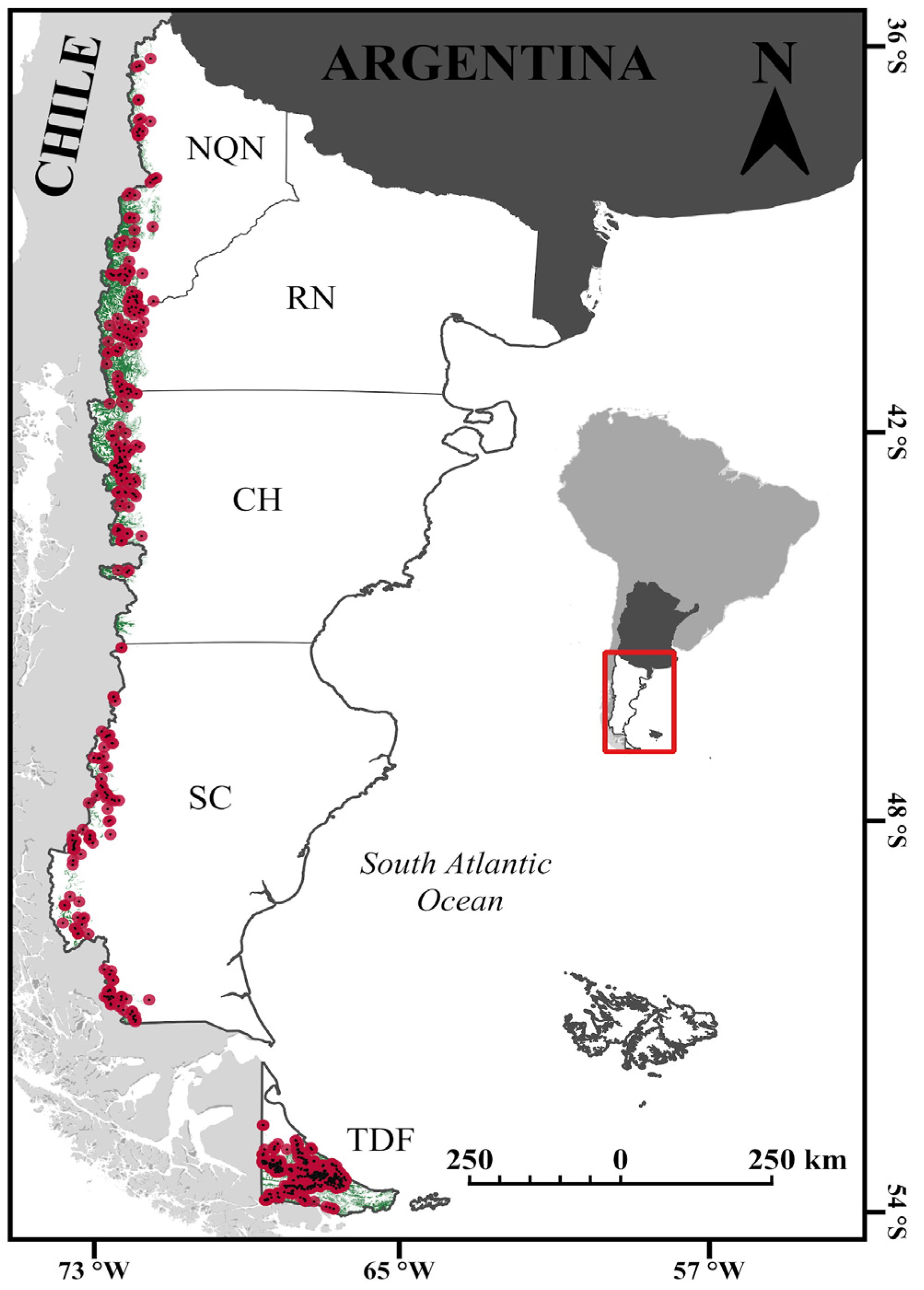

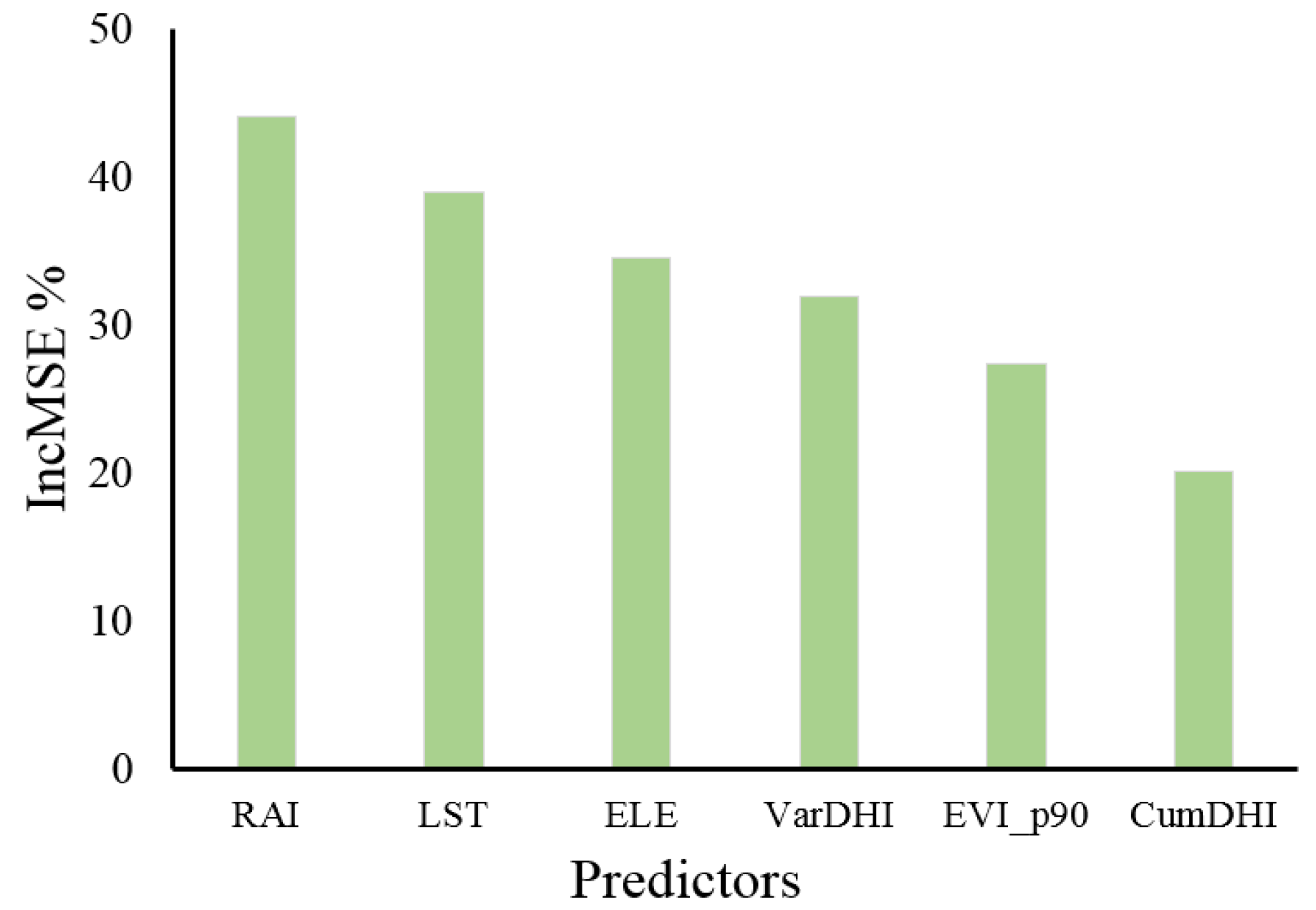
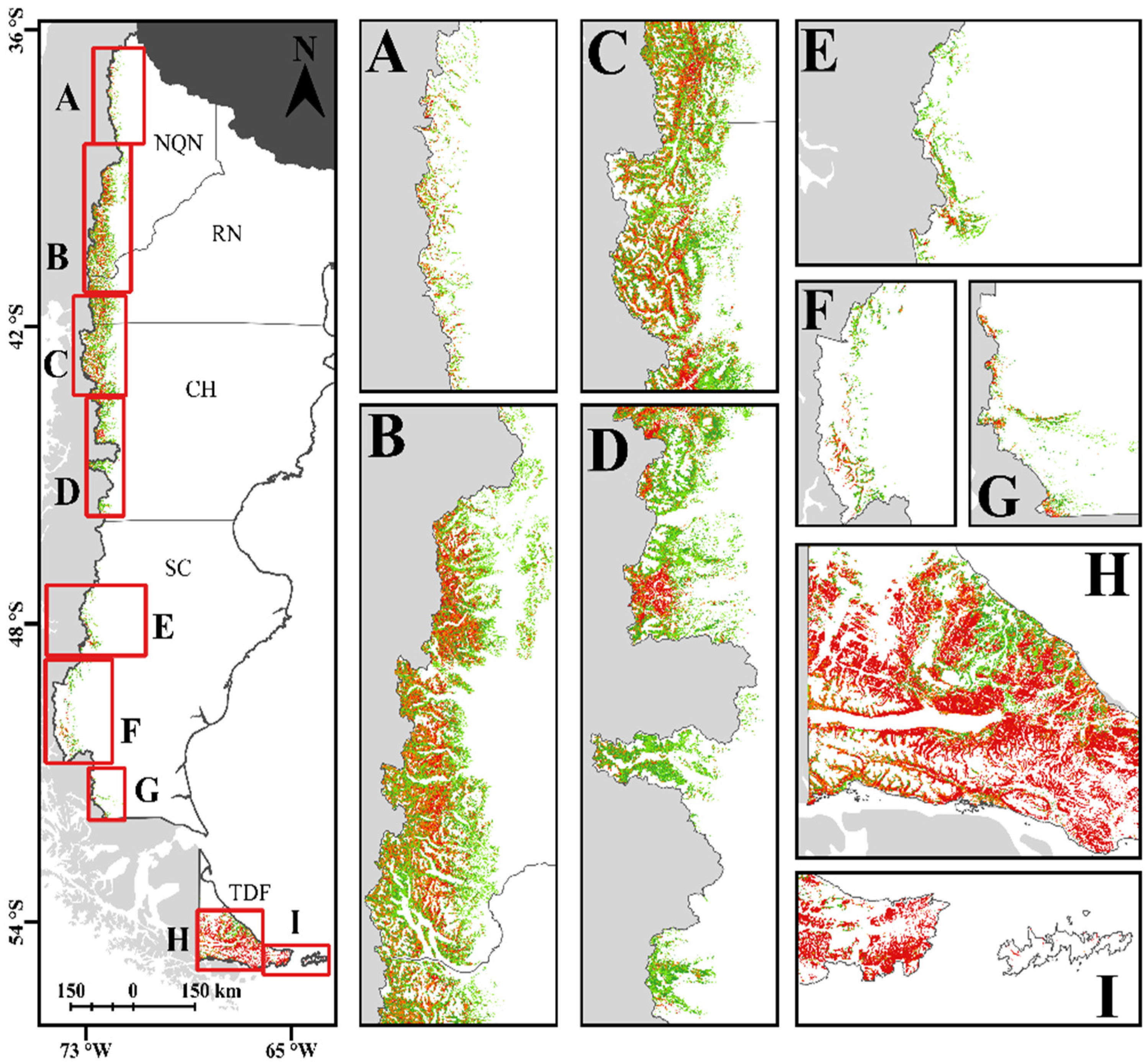
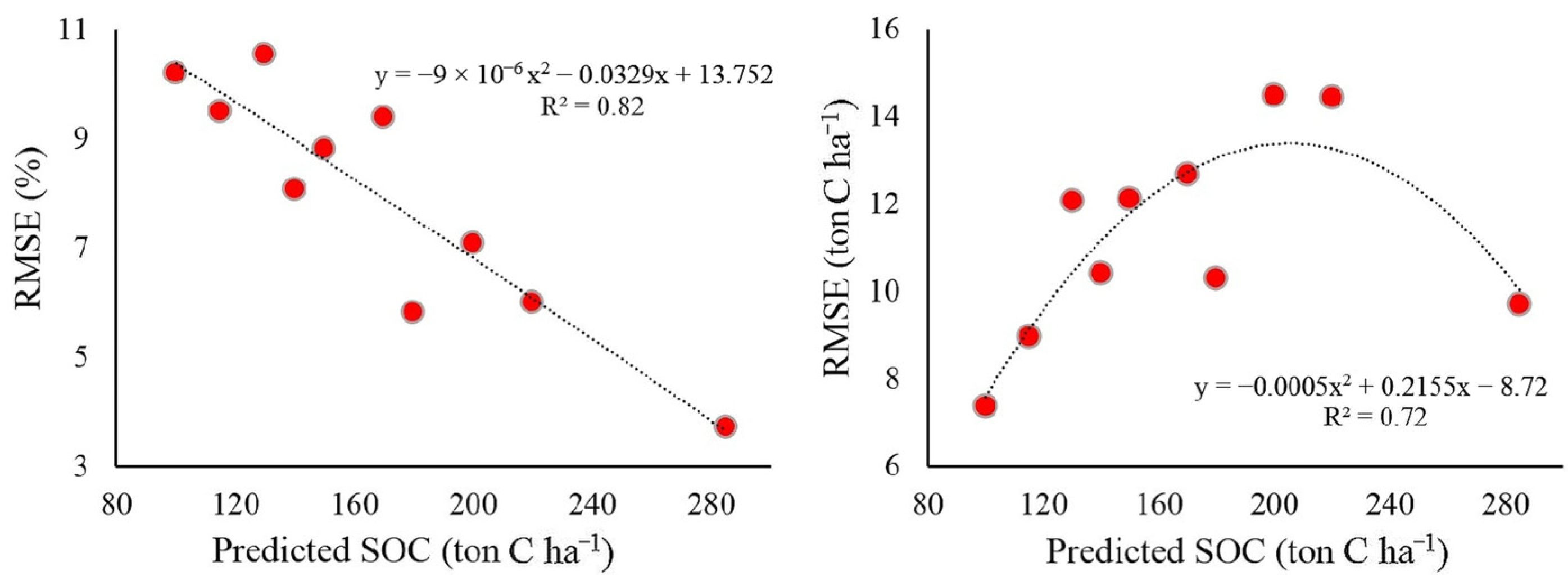
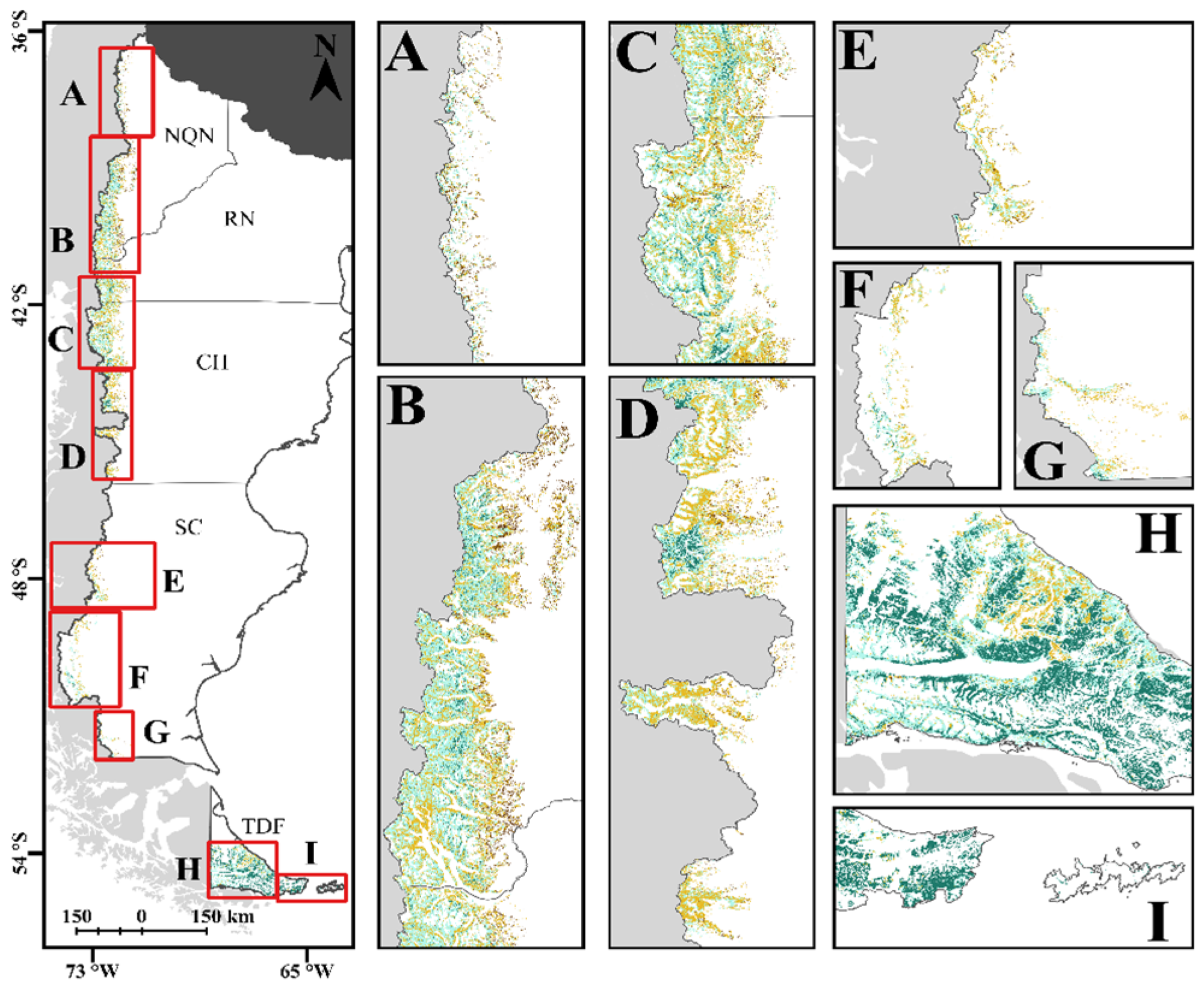

| Acronym | Description |
|---|---|
| NP | Forests with >70% basal area (BA) of Nothofagus pumilio, where the remaining 30% may be composed of other associated native tree species. |
| NA | Forests with >70% BA of N. antarctica, where the remaining 30% may be composed of other associated native tree species. |
| N-MIX | Pure and mixed deciduous Nothofagus forests, where >70% BA belongs to other deciduous Nothofagus species such as N. obliqua and N. alpina, where the remaining 30% may be composed for other associated native tree species. |
| N-EVE | Pure evergreen Nothofagus forests, where >70% BA belongs to evergreen Nothofagus species such as N. dombeyi and N. betuloides, and the remaining 30% may be composed of other associated native tree species. |
| CON | Pure and mixed coniferous forests, where >70% BA belongs to Austrocedrus chilensis, Araucaria araucana, Fitzroya cupressoides, Pilgerodendron uviferum, and other native coniferous species, where the remaining 30% may be composed of other associated native tree species. |
| EVE | Pure and mixed broadleaved evergreen forests, where >70% BA belongs to Maytenus boaria, Lomatia hirsuta, Luma apiculata, Myrceugenia exsucca, and other native broadleaved species, where the remaining 30% may be composed of other associated native tree species. |
| MIX | Mixed forests combining native broadleaved and deciduous tree species, where none exceeds 70% BA, and which do not fit into the above categories. |
| Type | TDF | SC | CHU | RN | NQN | Total | |
|---|---|---|---|---|---|---|---|
| Area | NP | 4054.0 | 2104.4 | 4232.4 | 1835.2 | 4001.2 | 16,227.3 |
| NA | 2007.3 | 260.2 | 2239.1 | 747.7 | 1023.8 | 6278.0 | |
| N-MIX | 0.0 | 30.2 | 14.4 | 7.2 | 253.6 | 305.5 | |
| N-EVE | 1013.7 | 0.0 | 1013.4 | 546.4 | 1198.2 | 3771.8 | |
| CON | 0.0 | 0.1 | 521.7 | 318.4 | 956.2 | 1796.5 | |
| EVE | 0.0 | 0.0 | 26.3 | 9.6 | 15.3 | 51.2 | |
| MIX | 217.4 | 75.0 | 344.0 | 275.9 | 729.1 | 1641.4 | |
| Total | 7292.4 | 2469.8 | 8391.4 | 3740.5 | 8177.6 | 30,071.7 | |
| N Plots | NP | 709 | 44 | 27 | 3 | 3 | 786 |
| NA | 243 | 74 | 48 | 0 | 11 | 376 | |
| N-MIX | 0 | 3 | 1 | 1 | 20 | 25 | |
| N-EVE | 24 | 0 | 2 | 3 | 2 | 31 | |
| CON | 0 | 1 | 21 | 14 | 36 | 72 | |
| EVE | 0 | 0 | 3 | 2 | 3 | 8 | |
| MIX | 5 | 5 | 5 | 2 | 5 | 22 | |
| Total | 981 | 127 | 107 | 25 | 80 | 1320 | |
| Sampling effort | NP | 16.7% | −50.6% | −25.2% | −37.1% | −45.2% | 5.6% |
| NA | −2.8% | 47.7% | 18.2% | −20.0% | 1.2% | 7.6% | |
| N-MIX | 0.0% | 1.1% | 0.8% | 3.8% | 21.9% | 0.9% | |
| N-EVE | −11.5% | 0.0% | −10.2% | −2.6% | −12.2% | −10.2% | |
| CON | 0.0% | 0.8% | 13.4% | 47.5% | 33.3% | −0.5% | |
| EVE | 0.0% | 0.0% | 2.5% | 7.7% | 3.6% | 0.4% | |
| MIX | −2.5% | 0.9% | 0.6% | 0.6% | −2.7% | −3.8% | |
| Total | 50.1% | 1.4% | −19.8% | −10.5% | −21.1% |
| Type | FC (km2) | SOC (ton C ha−1) | SD (ton C ha−1) | Total SOC (million ton C) | |
|---|---|---|---|---|---|
| Total | 30,071.7 | 134.4 | 25.2 | 404.2 | |
| Forest types | NP | 16,227.3 | 134.8 | 23.1 | 218.7 |
| NA | 6278.0 | 131.7 | 23.0 | 82.7 | |
| N-MIX | 305.5 | 128.7 | 18.6 | 3.9 | |
| N-EVE | 3771.8 | 145.5 | 32.0 | 54.9 | |
| CON | 1796.5 | 116.4 | 22.9 | 20.9 | |
| EVE | 51.2 | 124.0 | 17.9 | 0.6 | |
| MIX | 1641.4 | 136.6 | 24.9 | 22.4 | |
| Province | TDF | 7292.4 | 158.1 | 27.9 | 115.3 |
| SC | 2469.8 | 125.4 | 16.1 | 31.0 | |
| CHU | 8391.4 | 127.6 | 17.3 | 107.1 | |
| RN | 3740.5 | 128.5 | 16.2 | 48.1 | |
| NQN | 8177.6 | 125.6 | 20.7 | 102.7 | |
| OTBN | Red | 8791.3 | 139.0 | 27.3 | 122.2 |
| Yellow | 10,200.7 | 136.2 | 26.2 | 139.0 | |
| Green | 489.8 | 131.5 | 18.9 | 6.4 | |
| Unclassified | 10,589.9 | 129.0 | 21.3 | 136.6 | |
| Reserve networks | NAT | 9986.5 | 131.5 | 16.3 | 131.3 |
| PRO | 889.1 | 129.3 | 19.1 | 11.5 | |
| UNP | 19,196.1 | 136.2 | 28.8 | 261.4 | |
Publisher’s Note: MDPI stays neutral with regard to jurisdictional claims in published maps and institutional affiliations. |
© 2022 by the authors. Licensee MDPI, Basel, Switzerland. This article is an open access article distributed under the terms and conditions of the Creative Commons Attribution (CC BY) license (https://creativecommons.org/licenses/by/4.0/).
Share and Cite
Martínez Pastur, G.; Aravena Acuña, M.-C.; Silveira, E.M.O.; Von Müller, A.; La Manna, L.; González-Polo, M.; Chaves, J.E.; Cellini, J.M.; Lencinas, M.V.; Radeloff, V.C.; et al. Mapping Soil Organic Carbon Content in Patagonian Forests Based on Climate, Topography and Vegetation Metrics from Satellite Imagery. Remote Sens. 2022, 14, 5702. https://doi.org/10.3390/rs14225702
Martínez Pastur G, Aravena Acuña M-C, Silveira EMO, Von Müller A, La Manna L, González-Polo M, Chaves JE, Cellini JM, Lencinas MV, Radeloff VC, et al. Mapping Soil Organic Carbon Content in Patagonian Forests Based on Climate, Topography and Vegetation Metrics from Satellite Imagery. Remote Sensing. 2022; 14(22):5702. https://doi.org/10.3390/rs14225702
Chicago/Turabian StyleMartínez Pastur, Guillermo, Marie-Claire Aravena Acuña, Eduarda M. O. Silveira, Axel Von Müller, Ludmila La Manna, Marina González-Polo, Jimena E. Chaves, Juan M. Cellini, María V. Lencinas, Volker C. Radeloff, and et al. 2022. "Mapping Soil Organic Carbon Content in Patagonian Forests Based on Climate, Topography and Vegetation Metrics from Satellite Imagery" Remote Sensing 14, no. 22: 5702. https://doi.org/10.3390/rs14225702
APA StyleMartínez Pastur, G., Aravena Acuña, M.-C., Silveira, E. M. O., Von Müller, A., La Manna, L., González-Polo, M., Chaves, J. E., Cellini, J. M., Lencinas, M. V., Radeloff, V. C., Pidgeon, A. M., & Peri, P. L. (2022). Mapping Soil Organic Carbon Content in Patagonian Forests Based on Climate, Topography and Vegetation Metrics from Satellite Imagery. Remote Sensing, 14(22), 5702. https://doi.org/10.3390/rs14225702












